
Europe and Mediterranean: Italy, Croatia, and Greece Cruise
Princess Cruises
Once home to ancient civilizations and famous philosophers, the Mediterranean continues to define tradition. Explore Pompeii's ruins while visiting Naples, discover the turbulent history of Valetta and walk through fascinating cultural sites in Split.

Executive Member Benefit
Executive Members receive an annual 2% Reward, up to $1,250, on qualified Costco Travel purchases
Digital Costco Shop Card
Member Exclusive: Digital Costco Shop Card with every Princess Cruises® sailing†
Sailing Itinerary
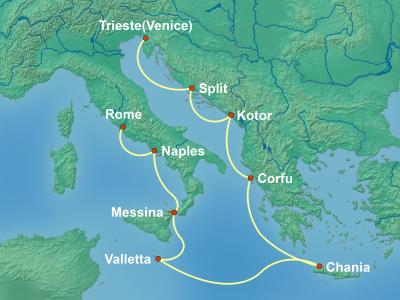
Note: Cruise itineraries are subject to change. Please verify ports and times directly with the cruise line.
Overview
Located about 80 kilometers northwest of Rome, the Port of Civitavecchia is the port of Rome and a busy ferry and cargo port serving Italy and southern Europe. Lying on Italy’s eastern shores on the Tyrrhenian Sea, the Port of Civitavecchia has excellent direct connections to Rome. It is an important cruise and ferry port with regular passage to Sardinia, Malta, Sicily, Tunis, and Barcelona. Fishing is of secondary importance to the Port of Civitavecchia. In addition to ocean-going traffic, the Port of Civitavecchia also contains a thermoelectric center and metallurgical works. In 2006, over 51 thousand people called the Port of Civitavecchia home. The Port of Civitavecchia was built on an earlier Etruscan settlement. Emperor Trajan founded the Port of Civitavecchia in the early 2nd Century, calling it Centumcellae. Today, Trajan’s Port is preserved within today’s Port of Civitavecchia. A busy growing town during the late Roman era, the Port of Civitavecchia was attacked by Vandals and then destroyed by the Saracens in 828 AD. Residents escaped to the nearby Allumiere Mountains where Pope Leo IV built a walled town in 854. Eventually, the people returned to Civitavecchia (the name means “old city”). At the end of the 15th Century, the Port of Civitavecchia was under frequent attack by pirates. The naval arsenal was constructed in 1508. Pope Paul III commissioned the building of the keep, which was designed by Donato Bramante and then finished by Michelangelo in 1537, to protect the Port of Civitavecchia from pirate attacks. In 1696, Civitavecchia became a free port under Pope Innocent XII. Because it was Rome’s main port, the French occupied the Port of Civitavecchia in 1849. The Port of Civitavecchia was linked to Rome by the Rome and Civitavecchia Rail Road in 1859. When the Port of Civitavecchia became part of the Kingdom of Italy in 1870, it was one of the Papal State’s most strongly fortified towns when Papal troops welcomed General Nino Bixio on behalf of the Italian unification forces into the Port of Civitavecchia fortress. World War II brought destruction to as much as three-quarters of the Port of Civitavecchia. Reconstruction enlarged the Port of Civitavecchia beyond its pre-war area. The Authority Portuale Civitavecchia (Port of Rome) is responsible for managing and operating the Port of Civitavecchia as well as the ports of Fiumicino and Gaeta. The modern Port of Civitavecchia is at the center of rail, road, and air networks that link it with central Italy and the world. The Port of Civitavecchia can handle about 11 million tons of cargo per year and over 1.5 million passengers. Cargoes include forest products, cereals, iron and steel, chemicals, automobiles, containers, and liquid bulk. In 2007, the Port of Civitavecchia welcomed 856 cruise vessels carrying 1.6 million passengers, and the total number of passengers using ferries and cruise vessels was 3.8 million. In 2007, the Port of Civitavecchia handled a total of 7.7 million tons of cargo. This total included 1.5 million tons of liquid bulk, 1.7 million tons of solid bulk, 4.6 million tons of packages, and 31.1 thousand TEUs of containerized cargo. The Port of Civitavecchia contains 28 berths of a total of 5.6 thousand meters in length alongside depths from 6 to 18 meters. Port properties include five warehouses containing 36 thousand square meters for handling and storing cargo. The intermodal terminal includes seven thousand square meters of storage space and 12.5 thousand square meters for loading/unloading rail cars and parking. The Port of Civitavecchia is one of the busiest ferry ports in the world. Just 80 kilometers northwest of Rome, it is the main tourist destination for people traveling to the Eternal City. It is also a central port for ferries carrying passengers to more local destinations. The ferry terminal offers a complete line of amenities. Different ferry companies offer services to various destinations. Moby Lines handles crossings to Olbia, Sardinia. Corsica Sardinia Ferries runs services to Golfo Aranci. Grimaldi Ferries carries passengers to Barcelona and Tunis, and Grand Navi Veloci operates a route to Tunis. Ferrovie dello Stato operates a combined rail-ferry service to Golfo Aranci.
Overview
Naples, a city in southern Italy, sits on the Bay of Naples. Nearby is Mount Vesuvius, the still-active volcano that destroyed the nearby Roman town of Pompeii. Dating to the 2nd millennium B.C., Naples has centuries of important art and architecture. The city's cathedral, the Duomo di San Gennaro, is filled with frescoes. Other major landmarks include the lavish Royal Palace and Castel Nuovo, a 13th-century castle.
Overview
Messina is a harbor city in northeast Sicily, separated from mainland Italy by the Strait of Messina. It’s known for the Norman Messina Cathedral, with its Gothic portal, 15th-century windows, and an astronomical clock on the bell tower. Nearby are marble fountains decorated with mythological figures, like the Fontana di Orione, with its carved inscriptions, and the Neptune Fountain, topped by a statue of the sea god.
Overview
If you've ever wondered what sort of prize you'd get for saving Europe, look no further than Valletta. Named after La Valette, the Grandmaster who masterminded Malta's successful stand against the Turkish siege of 1565, Valletta became the city of the Knights of the Order of St John and the seat of Malta's government. While traveling through the Mediterranean, Sir Walter Scott described Valletta as 'the city built by gentlemen for gentlemen'. Today it's a beautifully preserved 16th-century walled city, small enough to cover in a few hours without sweating too much in the Mediterranean sun. The streets were carefully laid out to channel cool breezes in from the harbour. Situated on the northeast coast of Malta, Valletta is the capital and is built on the promontory of Mount Sciberras which juts out into the middle of a bay. This dissects the bay into two deep harbors: the Grand Harbour to the east and the Marsamxett to the west. Valletta is a rough rectangle at the tip of a peninsula on the coast, just a few hundred meters across in either direction, and thus surrounded by water on its northern, eastern, and southern sides. The city was named after Jean Parisot de la Valette who was the Grand Master of the Order of the Knight Hospitallers (Knights of Saint John of Jerusalem). This famed religious order of hospitallers was founded in Jerusalem in the 11th century and made their base in Malta after they were expelled from Rhodes by the Ottoman Turks. During the time of Grand Master La Valette, in 1565, the Knights and the Maltese managed to suppress a siege on the island by the forces of Süleyman the Magnificent, Sultan of the Ottoman Empire in what was to become known as one of history's greatest sieges. Following the siege, the building of the city began in the same year 1565 to create a base for the defense of the island. Although Grand Master La Valette managed to lay the first stone, he died before its completion. Most of the embellishments of Valletta were done during the time of Grand Master La Cassiere, especially the magnificent St John's Co-Cathedral. The reign of the Knights of St John eventually came to an end with the successful invasion by Napoleon who occupied Malta on his way to Egypt. A Maltese revolt against the French garrison was the catalyst for the occupation of Valletta by the British in 1800. Valetta is also the spot where the Italian fleet surrendered to the Allies in 1943. Valletta's network of streets is laid out in an orthogonal grid dominated by a main artery that crosses the length of the entire city and opens up into a series of squares at its geometric center, around the Palace of the Grand Masters. The city architecture is inspired by Italian Renaissance planning principles and served as an early model of urban design. Valletta is one of the most important planned towns of the Renaissance. It equals in its noble architecture, any capital in Europe, while its timeless beauty and artistic treasures make it a well-deserved World Heritage site. There are several superb museums here as well as historical sites that are worth visiting. The main thoroughfare in the city is Republic Street. You'll find all the main shops and character-filled side streets leading off from here. For those interested in shopping, Merchant's Street and Lucia Street are the places to go for the most interesting merchandise. Lucia Street is famous for the exquisite silver and gold filigree jewelry sold there. Merchant Street specializes in souvenirs and is also home to a large open market.
Overview
This is the largest and most important town of western Crete, with a population of over 60,000 inhabitants. It is situated on the eastern shore of the bay of Chania and is built on the neck of the peninsula, on the site of ancient Kydonia. Chania has, to a large degree, retained its local color. It is one of the loveliest towns in Greece and the many vestiges of its past give it a particular charm. Entire Venetian, Turkish, and Jewish neighborhoods still survive, with well-preserved buildings, while the modern town, continuing to develop, is built according to well-designed plans, with parks and attractive edifices. It differs considerably from the tasteless big towns of today. Chania disposes of a large number of beds in hotels of various categories. There are also pensions and guest houses. There are many restaurants - some of them offering foreign specialties - tavernas, seafood restaurants, "ouzeries", pastry shops, coffee shops, pubs, etc. in every neighborhood and especially in the harbor area, which is lit up by the shop lights in the evenings and sparkles like a fairy-tale town.
Overview
Corfu Town (Kerkyra) is a principal port and the largest town in the Ionian islands. It is built between two Venetian castles, having its unique atmosphere. It is a thriving mass of shops and businesses, set amongst a captivating and charming assortment of elegant buildings, churches, imposing fortresses, and narrow alleyways leading to hidden squares. The tall buildings with the 'volta' (arches), the 'cantina' (narrow flagstoned streets), and the 'meralgia' (sea walls) are showing all a clear Italian influence. One of the most beautiful walks in the town is around the Esplanade (Spianada square), one of the biggest squares in Europe which is the hub of the Corfiot's life. Here you can walk around or sit in one of the many cafe bars underneath the arches of the 'Liston', a name probably derived from a similar promenade in Venice. Liston was built during the imperial French occupation and is reminiscent of the larger 'Arcades' of the Rue de Rivoli in Paris. On the upper side of the Esplanade stands a memorial to the British Lord High Commissioner Sir Thomas Maitland, built in 1816 in the shape of a circular building with Ionian columns. The Corfiots called this building 'sterna' (cistern) because this was where the entrance to the largest underground cistern of the town was to be found. Near the Maitland's monument, in front of the building where the Ionian Academy was housed, stands the statue of John Capodistrias, the first President of Greece. It is a work from the end of the 19th century showing the Governor standing deep in thought. Opposite the Liston is the Old Fortress and 'Anthonas', the Municipal Gardens. In the gardens is the statue of Lord Guilford, showing the founder of the Ionian Academy in his academic robes holding an open book. Nearby are the busts of two famous Corfiots, the poet Lorenzo Mavilis and the writer Dinos Theotokis. At the northern end of the Esplanade stands the Palace of St. Michael and St. George, one of the most elegant buildings in Corfu. Opposite the west front of the palace is a beautiful building that now houses the Reading Society of Corfu, the oldest cultural institute in modern Greece, founded in 1836. The Reading Society contains a unique library of Greek and foreign books as well as a large collection of manuscripts, newspapers, periodicals, paintings, maps and engravings mostly related to the Ionian islands. As one's gaze leaves the Esplanade, after lingering on the palace, it embraces a magnificent view towards the coastal road (Arseniou Street) with its sea walls Following along this road will take you to the Old Harbour of Corfu and the other Venetian castle, the one called the New Fortress. Along this road, the narrow lanes ('cantounia') lead to the Campielo, the oldest quarter of the town. Here the visitor can find the oldest houses and many of the historic churches in Corfu. At the northern end of Capodistria Street stands the Capodistria Mansion, an excellent example of neo-classical architecture. It was built in 1835 by the Corfiot architect John Chronis and is considered one of the most beautiful buildings in Greece. Here John Capodistrias, the first President of Greece, was born. Another notable landmark in the old town is the central market. The most interesting street here is Nickiforou Theotoki as the rows upon rows of 'volta' standing on their stone columns and the tall buildings form one of the most characteristic aspects of Corfu Town. In a little square on Nickiforou Theotoki Street stands the building of the Ionian Bank, which was built in 1846 displaying a well-proportioned facade with finely detailed Ionian pilasters and pediment. On the first floor of the building,g the Paper Money Museum is housed. At the far end of the square is the Church of St. Spyridon. It shelters the body of St. Spyridon, the patron saint of Corfu and one of the great Saints of Greek Orthodoxy, and draws a constant stream of pilgrims from all over Greece every year. On the Evgeniou Voulgareos Street stands the crenellated belfry of the Roman Catholic Church of the Annunciation a venerable building from the end of the 14th century. The whole building was destroyed in the World War II bombing, and the only remains are the belfry, two inscriptions, and a bas-relief representing war trophies. Between Evgeniou Voulgareos Street and a modern square stands the most elegant of the Venetian buildings in Corfu, the Town Hall in baroque style. At the end of Moustoxydi Street stands another building of the period of British rule, the historic Ionian Parliament. At the junction of the Garitsa coastal road and Alexandras Avenue stands the Douglas Obelisk, which also belongs to the same period, erected in honor of the Lord High Commissioner Sir Howard Douglas, to whom Corfu owes a lot of public works and philanthropic institutions.
Overview
Kotor is a fortified town on Montenegro’s Adriatic coast, in a bay near the limestone cliffs of Mt. Lovcen. Characterized by winding streets and squares, its medieval old town has several Romanesque churches, including Kotor Cathedral. It's also home to the Maritime Museum, which explores local seafaring history. Sveti Ðorde, one of 2 tiny islands off the ancient town of Perast, features a centuries-old church.
Overview
The City of Split marks 1700 years since the beginning of the construction of Diocletian's Palace. Split, a city where every epoche since antiquity has left its traces, was conceived within the walls of the palace which was built by the Roman Emperor Diocletian as his private residence. The well-preserved palace has been listed as UNESCO's register of the world's cultural heritage. During these 1700 years, Split has played an important role in Croatian history. Today, Split is the center of cultural and scientific life, with many institutions, museums, galleries, and theatres. Split is the second biggest city in Croatia. Due to its central position on the Adriatic coast and its exceptional environment, Split soon developed into the leading and biggest city of South Croatia, its large port, commercial and industrial center, and an important European tourist resort. The present city of Split is an organic fusion of its antique heritage and modern architecture, set up in a beautiful Mediterranean environment and full of the sober and thoughtful atmosphere of a big city. As the scientific center of the region, Split's scientific institutions have had remarkable results in many fields including the protection and study of cultural and natural heritage, oceanography, fishery, Adriatic agricultural cultures, etc. Split is also known for great accomplishments in sports, notably basketball, soccer, tennis, handball, rowing, sailing, and water polo. Split hosted the Mediterranean Sports Games and the European Athletic Championships. Split is connected by rail to the hinterland, by ferry boats to the Adriatic islands, Italy, and Croatia, and the rest of the world by its international airport.
Overview
Trieste is the capital city of the Friuli Venezia Giulia region in northeast Italy. A port city, it occupies a thin strip of land between the Adriatic coast and Slovenia’s border on the limestone-dominated Karst Plateau. Italian, Austro-Hungarian, and Slovenian influences are all evident in its layout, which encompasses a medieval old city and a neoclassical Austrian quarter.
Onboard the Majestic Princess
Majestic Princess
Year Built: 2017
Double Occupancy Capacity: 3560
Sail aboard Majestic Princess® and enjoy the signature favorites you’ve always loved, like Movies Under the Stars®, the SeaWalk® and the Lotus Spa®, as well as exciting additions including two specialty restaurants with dinner menus crafted by two Michelin-star awarded chefs.
Activities & Services (included in cruise)
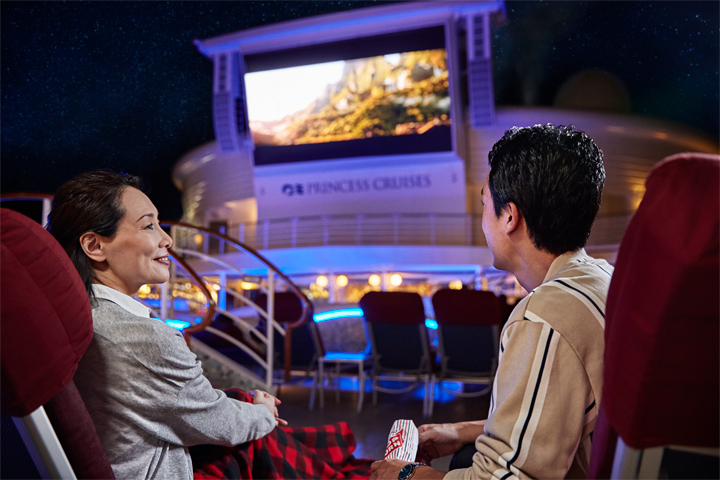
Movies
- Card Room
- Casino
- Disco/Nightclub
- Game Arcade
- Movies Under the Stars®
- Theater/Show Lounge
- Karaoke
- Fitness Center
- Educational Programs
- Miniature Golf
- Pool - Outdoor
- Pool - Indoor
- Sports Facilities
- Whirlpool/Jacuzzi
- Art Gallery
- Bars/Lounges
- Library
- Children's Indoor Play Area
- Educational Programs
- Organized Age Specific Activities
- Teen Center or Disco
- Teen Programs
- Business Center
- Concierge Desk
- Elevators
- Safe Deposit Boxes
Activities & Services (available for an extra fee)

The Lotus Spa
- Beauty Salon
- Fitness Classes
- Full-Service Spa
- Spa Services/Massage
- Sauna/Steam Room
- Internet Center
- Dry Cleaning/ Laundry Service
- Duty-Free Shops/Boutiques
- Infirmary/Medical Center
- Wedding/Vow Renewal

Dining Room
Main Dining
Concerto Dining Room: After final payment, through the MedallionClass® app, you may request your dining preference with Dine My Way℠. Customize your dining experiences nightly by choosing your seating time, dining companions and dietary needs.
Allegro Dining Room: After final payment, through the MedallionClass® app, you may request your dining preference with Dine My Way℠. Customize your dining experiences nightly by choosing your seating time, dining companions and dietary needs.
Symphony Dining Room: After final payment, through the MedallionClass® app, you may request your dining preference with Dine My Way℠. Customize your dining experiences nightly by choosing your seating time, dining companions and dietary needs.
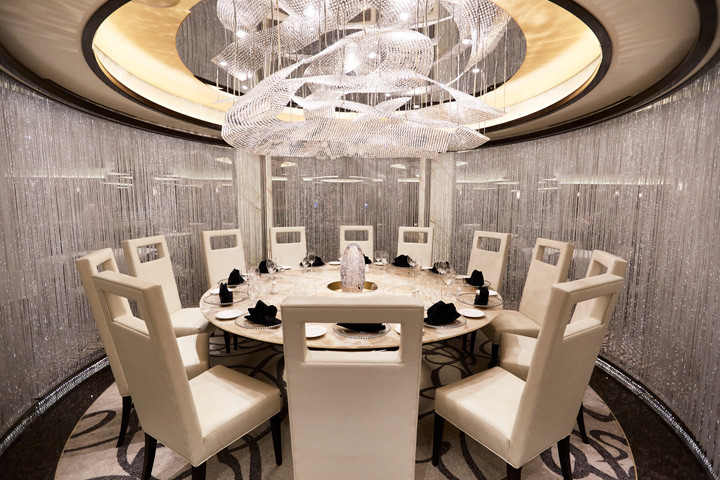
Chef's Table Lumiere
Specialty Dining
Chef’s Table Lumiere: A private dining experience that surrounds guests in a curtain of light. This restaurant is available for an additional cost.
Bistro Sur La Mer by Emmanuel Renaut: Savor casual French bistro-style dining with a modern twist at Bistro Sur La Mer, created with Chef Emmanuel Renaut, who holds the prestigious title of "Meilleur Ouvrier de France" (Best Craftsmen of France) and Chef of the Year by Le Chef, and whose Flocons de Sel restaurant has received three Michelin stars. Chef Renaut has created a tantalizing menu, showcasing authentic French dishes crafted with the Chef's signature flair. This restaurant is available for an additional cost.
Crown Grill℠: An upscale and more refined approach to the traditional steakhouse, this venue features some of the best, most tender cuts of beef, such as New York and porterhouse, plus a prime rib carving station. This restaurant is available for an additional cost.
Harmony: A specialty restaurant created in partnership with the former chef of Wing Lei – the first Chinese restaurant in North America awarded a Michelin star – Harmony, features Chef Richard Chen’s interpretation of classic Cantonese dishes. Chef Chen’s innovative plates demonstrate impeccable technique with a masterful balance of ingredients and flavors. This restaurant is available for an additional cost.
Lobster & Dim Sum Bar: This relaxed al fresco eatery on deck is the place to indulge in Grilled Lobster, Kung Pao Lobster or Salt & Pepper Lobster, all served with hearty sides. For an additional treat or an afternoon snack, you can also choose from three different varieties of delectable Dim Sum. Additional charge applies.
Yao Family Wines: Princess Cruises is proud to pour Yao Family Wines, an ultra-premium label from Napa Valley, California. Exclusive to Majestic Princess, these vintages are brought to us by NBA hall of fame Yao Ming. With their distinctive elegance, robustly deep fruit, and artisan winemaking techniques, Yao Family Wines are richly deserving of their critical acclaim. Raise a glass and savor the five varietals artfully paired with special dishes in the Yao Family Wines Winemakers Dinner.
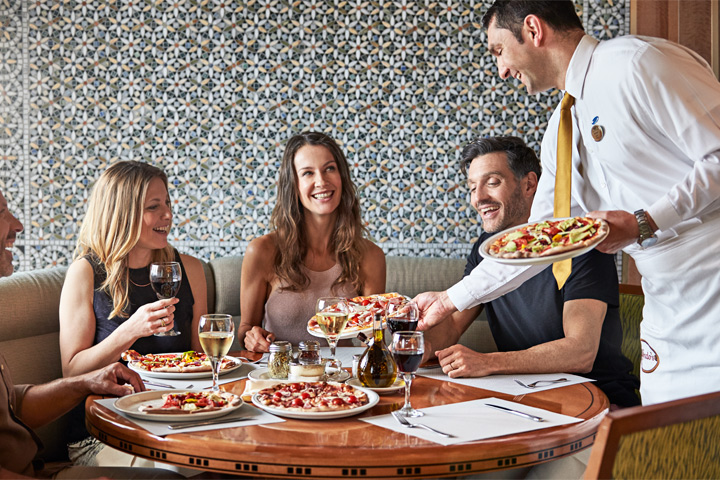
Alfredo's Pizzeria
Casual Dining
International Café: Open 24 hours a day, the International Café located in the Piazza is the place for an ever-changing array of small bite meals, treats and gourmet beverages. Grab a freshly baked croissant to start your day, snack on pies and quiche or choose from a wide variety of salads and sandwiches at lunchtime, and indulge in decadent desserts in the evening. Coffee and tea fans will love the New Grounds Crafted Coffee menu featuring a variety of specialty espresso-based drinks made from a custom blend of coffee beans, as well as iced tea fusions. This restaurant is available for an additional cost.
Alfredo's Pizzeria: This charming sit-down venue offers an enticing menu of freshly prepared individual-size pizzas along with beer and wines by the glass. The open kitchen design allows you to watch as the chefs create pizza by hand and serve them straight out of the oven.
World Fresh Marketplace: The World Fresh Marketplace boasts food stations from around the world that offer endless variety, regional favorites and customizable options for every palate.
The Bakery: An endless assortment of mouthwatering treats, from fresh pie and cakes to decadent pastries and more. The Bakery serves Western, European and Asian flavors and fare fresh from the oven.
Chopsticks Noodle Bar: Freshly prepared noodle soups and classic wok-fried noodle dishes make for the perfect light repast with an Asian twist. Enjoy favorites such as Sichuan Dan-Dan Noodles and Wonton Noodle Soup in a casual setting on deck, plus special menu items rotated daily.
Room Service: Call for room service delivery or order through OceanNow® in the Princess® MedallionClass® app at any time of the day or night. Guests with the latest Princess Plus and Princess Premier packages enjoy OceanNow® and room service delivery with no charge. Otherwise, a one-time access fee of US $ 14.99 per person per voyage will apply for OceanNow® delivery and a US $ 5 room service fee will apply for each order placed by stateroom phone. To order, guests can press the "Room Service" button on their stateroom phone, or order through OceanNow®.
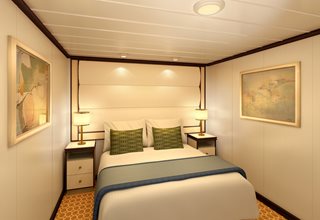
Category: IA
Approximately 175 sq. ft., this well-appointed interior stateroom provides fine amenities.

Category: IB
Approximately 166 to 175 sq. ft., this well-appointed interior stateroom provides fine amenities.

Category: IC
Approximately 166 to 175 sq. ft., this well-appointed interior stateroom provides fine amenities.

Category: ID
Approximately 166 sq. ft., this well-appointed interior stateroom provides fine amenities.

Category: IE
Approximately 166 sq. ft., this well-appointed interior stateroom provides fine amenities.

Category: IF
Approximately 166 sq. ft., this well-appointed interior stateroom provides fine amenities.
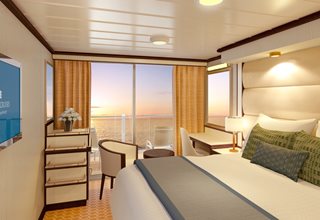
Category: BA
Approximately 222 sq. ft. including balcony, this stateroom provides outstanding views from a private balcony.

Category: BB
Approximately 222 sq. ft. including balcony, this stateroom provides outstanding views from a private balcony.

Category: BC
Approximately 222 sq. ft. including balcony, this stateroom provides outstanding views from a private balcony.

Category: BD
Approximately 222 sq. ft. including balcony, this stateroom provides outstanding views from a private balcony.

Category: BE
Approximately 222 sq. ft. including balcony, this stateroom provides outstanding views from a private balcony.

Category: BF
Approximately 222 sq. ft. including balcony, this stateroom provides outstanding views from a private balcony.

Category: BW
Approximately 222 sq. ft. including balcony, this stateroom provides a partial or obstructed view from a private balcony.
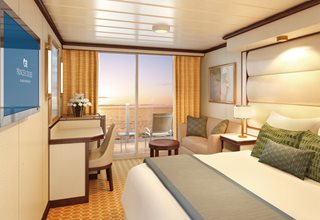
Category: DA
Approximately 233 sq. ft. including balcony, this larger than standard balcony stateroom provides outstanding views from a private balcony. Includes sofa bed.

Category: DB
Approximately 233 sq. ft. including balcony, this larger than standard balcony stateroom provides outstanding views from a private balcony. Includes sofa bed.

Category: DC
Approximately 233 sq. ft. including balcony, this larger than standard balcony stateroom provides outstanding views from a private balcony. Includes sofa bed.

Category: DD
Approximately 233 sq. ft. including balcony, this larger than standard balcony stateroom provides outstanding views from a private balcony. Includes sofa bed.

Category: DE
Approximately 233 - 303 sq. ft. including balcony, this larger than standard balcony stateroom provides outstanding views from a private balcony. Includes sofa bed.

Category: DF
Approximately 233 sq. ft. including balcony, this larger than standard balcony stateroom provides outstanding views from a private balcony. Includes sofa bed.

Category: D4
Approximately 242 to 312 sq. ft. including balcony, this stateroom provides dramatic views from a private balcony. Includes sofa bed.

Category: DW
Approximately 233 sq. ft. including balcony, this larger than standard balcony stateroom provides a partial or obstructed view from a private balcony.
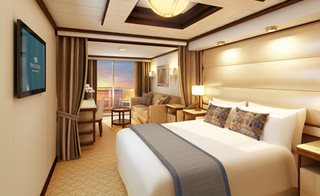
Category: M1
Approximately 314 sq. ft. including balcony, this spacious stateroom provides a seating area with sofa bed, and full bath with tub and shower.
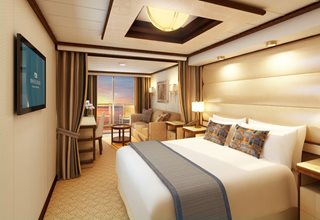
Category: M6
Approximately 340 sq. ft. including balcony, this extra-large stateroom provides outstanding views with seating area and sofa bed, and full bath with tub and shower.

Category: MA
Approximately 299 to 329 sq. ft. including balcony, this spacious stateroom provides a seating area with sofa bed, and full bath with tub and shower.

Category: MB
Approximately 299 sq. ft. including balcony, this spacious stateroom provides a seating area with sofa bed, and full bath with tub and shower.

Category: MC
Approximately 233 to 299 sq. ft. including balcony, this spacious stateroom provides a seating area with sofa bed, and full bath with tub and shower.

Category: ME
Approximately 299 sq. ft. including balcony, this spacious stateroom provides a seating area with sofa bed, and full bath with tub and shower.

Category: MF
Approximately 299 sq. ft. including balcony, this spacious stateroom provides a seating area with sofa bed, and full bath with tub and shower.
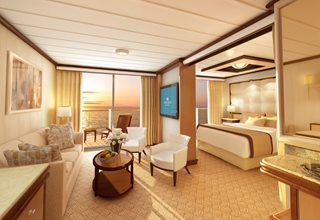
Category: S2
Approximately 587 to 682 sq. ft. including balcony, the Owner's Suite features an expansive stateroom and oversized aft-facing balcony. Exclusive suite-only benefits.

Category: S3
Approximately 587 to 682 sq. ft. including balcony, the Penthouse Suite features an expansive stateroom and oversized aft-facing balcony. Exclusive suite-only benefits.

Category: S4
Approximately 440 sq. ft. including balcony, the Penthouse Suite features a spacious stateroom with seating area and sofa bed. Enjoy suite-only upgrades and benefits.

Category: S5
Approximately 554 sq. ft. including balcony, the Premium Suite features a large stateroom with seating area and sofa bed. Enjoy suite-only upgrades and benefits.

| Symbol | Description |
|---|---|
 | Will accommodate third person |
 | Will accommodate third and fourth person |
 | Balcony access when in port only |
 | Balcony door blocked when upper berth is in use |
 | Connecting staterooms |
 | Fully accessible stateroom, roll-in shower only |
 | Will accommodate third and fourth person, fourth berth is a rollaway bed |
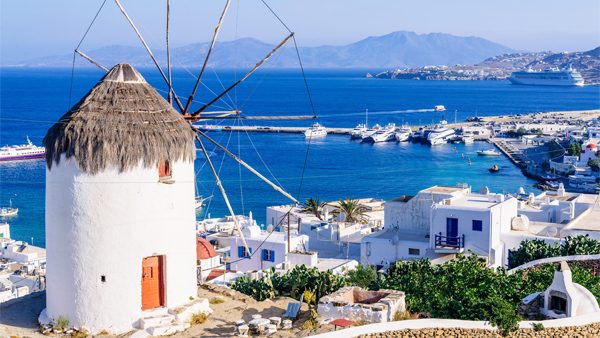
- Ship Name: Majestic Princess
- Year Built: 2017
- Year Entered Present Fleet: 2017
- Ship Class: Royal
- Number of Passenger Decks: 19
- Ocean-View with Balcony: 1,028
- Total Inside Staterooms: 342
- Tonnage (GRT): 141,000
- Capacity Based on Double Occupancy: 3,560
- Country of Registry: Bermuda
- Total Staterooms: 1,780
- Suites with Balcony: 410
Costco Member Reviews

Available Dates & Prices
Terms & Conditions
*Price shown is per person based on double occupancy and is valid for select stateroom categories only. Click on the Terms & Conditions link below for details.
†One Digital Costco Shop Card per room/stateroom, per stay. The exact amount of the Digital Costco Shop Card will be calculated during the booking process. The Digital Costco Shop Card promotion is nontransferable and may not be combined with any other promotion. A Digital Costco Shop Card will arrive by email approximately 10 days after the start of your cruise. Click on the Terms & Conditions link below for additional information.
© Princess Cruise Lines, Ltd. Ships of Bermudan and British registry.
Digital Costco Shop Card
This booking includes a Digital Costco Shop Card which will arrive by email one to two weeks after you return from your vacation. The Digital Costco Shop Card is a convenient payment option in our warehouses and on Costco.ca.
















